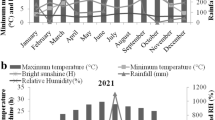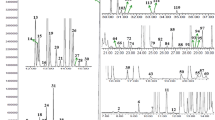Abstract
Many Heracleum L. taxa (Apiaceae) are used as food and spices, and in traditional medicine. In this work, the chemical composition of Heracleum pyrenaicum subsp. orsinii (Guss.) F. Pedrotti and Pignatti root, leaf and fruit essential oils, their antimicrobial activity and cytotoxic effect on malignant and normal cells were investigated for the first time. The composition of the oils was analyzed by GC and GC–MS. Monoterpenes prevailed in the root oil, with β-pinene (38.6%) being dominant, while in the leaf oil, sesquiterpenes, mostly (E)-nerolidol (20.5%) and (E)-caryophyllene (17.0%), were the most abundant constituents. The fruit oil contained the majority of aliphatic esters, mainly octyl acetate (36.8%) and octyl hexanoate (22.1%). The antimicrobial activity was determined by microdilution method against eight bacteria and eight fungi (standard strains, clinical or food isolates). The best antibacterial activity, better than the activity of ampicillin, was shown by the root oil against Salmonella typhimurium, Escherichia coli and Pseudomonas aeruginosa. The strongest antifungal activity, stronger than the activity of ketoconazole, was exhibited by the leaf and root oils against Trichoderma viride, and by the root oil against Aspergillus ochraceus. The cytotoxic effect of the oils, determined by MTT test, was prominent against malignant HeLa, LS174 and A549 cells (IC50 = 6.49–14.56 μg/mL). On the other hand, the oils did not show toxicity against normal MRC-5 cells at tested concentrations (IC50 > 200.00 μg/mL). It can be concluded that investigated H. pyrenaicum subsp. orsinii oils represent potential new raw materials for food and pharmaceutical industry.
Similar content being viewed by others
References
Adams RP (2007) Identification of essential oil components by gas chromatography/mass spectroscopy, 4th edn. Allured Publishing Corporation, Carol Stream
Bakkali F, Averbeck S, Averbeck D, Idaomar M (2008) Biological effects of essential oils—a review. Food Chem Toxicol 46:446–475
Başer HCK (2002) Aromatic biodiversity among the flowering plant taxa of Turkey. Pure Appl Chem 74:527–545
Basílico MZ, Basílico JC (1999) Inhibitory effects of some spice essential oils on Aspergillus ochraceus NRRL 3174 growth and ochratoxin A production. Lett Appl Microbiol 29:238–241
Bicchi C, D’Amato A, Frattini C, Cappelletti EM, Caniato R, Filippini R (1990) Chemical diversity of the contents from the secretory structures of Heracleum sphondylium subsp. sphondylium. Phytochemistry 29:1883–1887
Bourgou S, Pichette A, Marzouk B, Legault J (2010) Bioactivities of black cumin essential oil and its main terpenes from Tunisia. S Afr J Bot 76:210–216
Brummitt RK (1968) Heracleum L. In: Tutin TG, Heywood VH, Burges NA, Moore DM, Valentine DH, Walters SM, Webb DA (eds) Flora Europaea, vol 2. Cambridge University Press, London, pp 364–366
Burt S (2004) Essential oils: their antibacterial properties and potential applications in foods—a review. Int J Food Microbiol 94:223–253
Chauhan RS, Nautiyal MC, Tava A, Cecotti R (2014) Essential oil composition from leaves of Heracleum candicans Wall.: a sustainable method for extraction. J Essent Oil Res 26:130–132
CLSI (2009) Methods for dilution antimicrobial susceptibility tests for bacteria that grow aerobically. Approved standard, 8th edn. CLSI publication M07-A8. Clinical and Laboratory Standards Institute, Wayne
Da Silva SL, Figueiredo PM, Yano T (2007) Cytotoxic evaluation of essential oil from Zanthoxylum rhoifolium Lam. leaves. Acta Amazonica 37:281–286
De Miguel D, Gómez P, González R, García-Suárez J, Cuadros JA, Bañas MH, Romanyk J, Burgaleta C (2005) Nonfatal pulmonary Trichoderma viride infection in an adult patient with acute myeloid leukemia: report of one case and review of the literature. Diagn Microbiol Infect Dis 53:33–37
Espinel-Ingroff A (2001) Comparation of the E-test with the NCCLS M38-P method for antifungal susceptibility testing of common and emerging pathogenic filamentous fungi. J Clin Microbiol 39:1360–1367
Hajhashemi V, Sajjadi SE, Heshmati M (2009) Anti-inflammatory and analgesic properties of Heracleum persicum essential oil and hydroalcoholic extract in animal models. J Ethnopharmacol 124:475–480
Hänel H, Raether W (1988) A more sophisticated method of determining the fungicidal effect of water-insoluble preparations with a cell harvester, using miconazole as an example. Mycoses 31:148–154
Jun NJ, Mosaddik A, Moon JY, Jang K, Lee D, Ahn KS, Cho SK (2011) Cytotoxic activity of β-caryophyllene oxide isolated from jeju guava (Psidium cattleianum Sabine) leaf. Rec Nat Prod 5:242–246
Karuppusamy S, Muthuraja G (2011) Chemical composition and antioxidant activity of Heracleum sprengelianum (Wight and Arnott) essential oils growing wild in peninsular India. Iran J Pharm Res 10:769–775
Kubo I, Morimitsu Y (1995) Cytotoxicity of green tea flavor compounds against two solid tumor cells. J Agric Food Chem 43:1626–1628
Kuljanabhagavad T, Sriubolmas N, Ruangrungsi N (2011) Chemical composition, antibacterial and antifungal activities of essential oil from Heracleum siamicum Craib. Pharm Chem J 45:178–182
Maggi F, Quassinti L, Bramucci M, Lupidi G, Petrelli D, Vitali LA, Papa F, Vittori S (2014) Composition and biological activities of hogweed [Heracleum sphondylium L. subsp. ternatum (Velen.) Brummitt] essential oil and its main components octyl acetate and octyl butyrate. Nat Prod Res 28:1354–1363
Mosmann T (1983) Rapid colorimetric assay for cellular growth and survival: application to proliferation and cytotoxicity assays. J Immunol Methods 65:55–63
Nitz S, Spraul MH, Drawert F (1990) C17 polyacetylenic alcohols as the major constituents in roots of Petroselinum crispum Mill. ssp. tuberosum. J Agric Food Chem 38:1445–1447
Ohno M, Abe T (1991) Rapid colorimetric assay for the quantification of leukemia inhibitory factor (LIF) and interleukin-6 (IL-6). J Immunol Methods 145:199–203
Pignatti S (1982) Flora d’Italia, vol 2. Edagricole, Bologna
Pimenov MG, Leonov MV (2004) The Asian Umbelliferae biodiversity database (ASIUM) with particular reference to South-West Asian taxa. Turk J Bot 28:139–145
Pommerville JC (2011) Alcamo’s fundamentals of microbiology. Jones and Bartlett Publishers, Sudbury
Rašić A (2002) Preživeti u prirodi. Kolor pres, Lapovo
Setzer WN, Schmidt JM, Noletto JA, Vogler B (2006) Leaf oil compositions and bioactivities of Abaco bush medicines. Pharmacologyonline 3:794–802
Soković M, Glamočlija J, Marin PD, Brkić D, Van Griensven LJLD (2010) Antibacterial effects of the essential oils of commonly consumed medicinal herbs using an in vitro model. Molecules 15:7532–7546
Suffness M, Pezzuto JM (1991) Assay related to cancer drug discovery. In: Hostettmann K (ed) Methods in plant biochemistry. Assays for bioactivity, vol 6. Academic Press, London
Tao R, Wang C, Kong Z (2013) Antibacterial/antifungal activity and synergistic interactions between polyprenols and other lipids isolated from Ginkgo biloba L. leaves. Molecules 18:2166–2182
Tkachenko KG (2009) Essential oils from roots of certain Heracleum species. Chem Nat Compd 45:578–581
Tonascia N (1992) Biosystematische Untersuchungen an Heracleum sphondylium s.l. in der Schweiz. Ber Geobot Inst ETH 58:101–120
Tsukatani T, Suenaga H, Shiga M, Noguchi K, Ishiyama M, Ezoe T, Matsumoto K (2012) Comparison of the WST-8 colorimetric method and the CLSI broth microdilution method for susceptibility testing against drug-resistance bacteria. J Microbiol Methods 90:160–166
Vračarić B, Bakić J, Čolić D, Lintner V, Micković M, Rajšić R, Stevanović D, Uvalin M (1977) Ishrana u prirodi. Vojnoizdavački zavod, Narodna knjiga, Belgrade
Acknowledgements
This work was supported by the Ministry of Education, Science and Technological Development of the Republic of Serbia under Grants Nos. 173021, 173032 and 175011.
Author information
Authors and Affiliations
Corresponding author
Rights and permissions
About this article
Cite this article
Ušjak, L., Petrović, S., Drobac, M. et al. Edible wild plant Heracleum pyrenaicum subsp. orsinii as a potential new source of bioactive essential oils. J Food Sci Technol 54, 2193–2202 (2017). https://doi.org/10.1007/s13197-017-2610-z
Revised:
Accepted:
Published:
Issue Date:
DOI: https://doi.org/10.1007/s13197-017-2610-z




